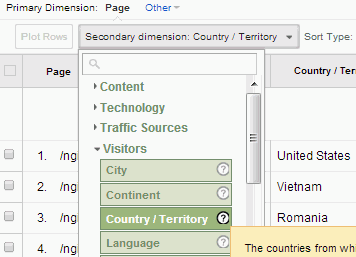Enhance Your Data Analysis Utilizing Second Dimension in Google Analytics
Exploring the abilities of additional dimensions in Google Analytics opens a world of possibilities for refining information evaluation. The capacity to explore details even more past the surface area degree offers a nuanced sight that can shape critical decisions. By layering extra measurements onto main information sets, an even more complex narrative arises, losing light on user interactions and performance signs. This vibrant approach to data examination holds the essential to unlocking covert patterns and trends that might transform how services interpret their electronic footprint.
Comprehending Secondary Dimensions
Second measurements in Google Analytics refer to additional specifications that can be added to the main measurement, allowing for an extra comprehensive evaluation of data (Secondary Dimension in Google Analytics). By incorporating additional dimensions, analysts can section and filter data to reveal patterns, fads, and relationships that might not be obvious when looking at the information as a whole.

Advantages of Making Use Of Additional Measurements
When examining information in Google Analytics, the application of secondary dimensions uses important insights right into customer behavior and efficiency metrics. By including a second dimension to your key data, you can dive much deeper right into the attributes of your website site visitors and their communications. Among the essential benefits of making use of second dimensions is the capability to sector and compare data much more successfully. This segmentation permits you to comprehend exactly how various variables, such as demographics or web traffic sources, influence individual actions and conversions (Secondary Dimension in Google Analytics).
Furthermore, additional dimensions improve the context of your primary data, supplying a much more extensive sight of individual interaction and performance metrics. On the whole, the use of second measurements in Google Analytics can dramatically improve the depth and top quality of your information analysis, leading to even more informed decision-making and enhanced results.
Exactly How to Add Secondary Measurements
By including additional measurements in Google Analytics, customers can gain much deeper understandings into their information analysis process, enabling more thorough analysis of individual behavior and performance metrics. Including second dimensions is an uncomplicated procedure that can dramatically improve the deepness of analysis. To include an additional measurement in Google Analytics, begin by browsing to the record you intend to evaluate. When in the record, situate the "Second dimension" tab over the information table. Click on it to reveal a dropdown food selection with different alternatives such as Habits, Modern Technology, and Custom-made Dimensions. Select the measurement you wish to include, such as 'Source/Medium' or 'Gadget Category'. great site This second measurement will certainly then be used to your existing information, providing extra context and enabling a much more detailed analysis of user interactions. By utilizing additional dimensions effectively, individuals can reveal valuable insights that might have or else been neglected, resulting in notified decision-making and improved efficiency methods.
Analyzing Data With Additional Measurements
Using second dimensions in data analysis provides an extra thorough understanding of user habits and performance metrics. By including a second measurement to your main data established in Google Analytics, you can delve much deeper right into the features of your internet site site visitors and their interactions. As an example, incorporating the primary measurement of 'source/medium' with the second measurement of 'landing web page' can disclose which details pages are attracting web traffic from various sources, assisting you maximize these web pages for better involvement.

Basically, assessing information with second dimensions empowers you to obtain beneficial insights into individual habits, identify fads, and make informed choices to Get More Information improve the efficiency of your digital homes.
Best Practices for Second Measurements
In information analysis, incorporating additional dimensions effectively can significantly enhance the deepness of insights originated from metrics and user habits patterns. When using secondary dimensions in Google Analytics or any kind of various other logical tool, it is vital to comply with best methods to guarantee the precision and relevance of the data analysis.
One secret best technique is to meticulously pick additional measurements that match the key dimension being analyzed. Picking second measurements that provide additional context or further division can provide a much more thorough understanding of the data. It is also crucial to avoid overcomplicating the analysis by including way too many secondary measurements, which might cause confusion or dilution of insights.
Additionally, it is recommended to experiment with different mixes of secondary and primary measurements to discover new relationships and fads. Frequently fine-tuning the choice and reviewing of second measurements based on the particular goals of the analysis can bring about more workable insights. By adhering to these best techniques, data analysts can take advantage of secondary measurements effectively to boost the total data analysis procedure and decision-making abilities.

Verdict
To conclude, integrating additional measurements in Google Analytics is necessary for a thorough data analysis method. By leveraging second dimensions along with key ones, marketing experts and analysts can discover useful insights and connections that can inform decision-making and optimize digital advertising and marketing approaches. Understanding how to properly utilize additional measurements and adhering to best methods will allow experts to remove significant data and boost their general efficiency sites metrics.
Additional dimensions in Google Analytics refer to extra specifications that can be added to the primary measurement, allowing for a more thorough evaluation of data. By incorporating second dimensions, experts can sector and filter information to reveal patterns, trends, and connections that could not be apparent when looking at the data as a whole. Combining the primary measurement of 'source/medium' with the second measurement of 'touchdown web page' can disclose which certain web pages are attracting web traffic from different resources, aiding you enhance these web pages for far better engagement.
One secret ideal technique is to very carefully select additional dimensions that enhance the main measurement being assessed. By adhering to these best techniques, information analysts can take advantage of secondary dimensions successfully to enhance the overall data evaluation process and decision-making capabilities.